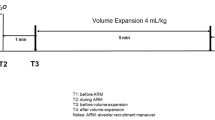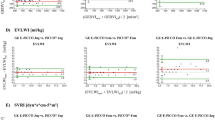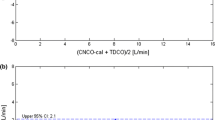Abstract
Objective
To analyze the correlation between initial distribution volume of glucose (IDVGI) and intrathoracic blood volume measured by single indicator dilution technique.
Design and setting
Prospective clinical study conducted in the intensive care unit of a university hospital.
Patients and methods
We enrolled 20 consecutive adult patients requiring hemodynamic monitoring with arterial pulse contour analysis system (PiCCO) and without any underlying pathology inducing generalized protein capillary leakage and/or marked peripheral edema. Cardiac output, intrathoracic blood volume, extravascular lung water were recorded. IDVGI was measured once per day for the first 5 days after PiCCO positioning by administering a bolus of 25 ml 20% glucose (5 g) over 30 s through a central venous catheter. The relationship between IDVGI and other variables was studied by regression analysis. Receiver operating characteristic curves were used to study the relationship between changes in IDVGI and changes in cardiac index, intrathoracic blood volume, and central venous pressure.
Results
A good linear correlation was obtained between intrathoracic blood volume and IDVGI (R2=0.79). Receiver operating characteristic curve analysis showed a good ability of initial distribution volume of glucose variations to reflect cardiac index variations.
Conclusions
Our results indicate that IDVGI can serve as noninvasive indicator of cardiac preload.




Similar content being viewed by others
References
Sinclair S, James S, Singer M (1997) Intraoperative intravascular volume optimisation and length of hospital stay after repair of proximal femoral fracture: randomised controlled trial. BMJ 315:909–912
Shoemaker WC, Parsa MH (1995) Invasive and noninvasive physiologic monitoring. In: Ayres SM, Grenvik A, Holbrook PR, Shoemaker WC (eds) Textbook of critical care, 3rd edn. Harcourt Brace, Philadelphia, pp 252–266
Sakka SG, Brendle DL, Reinhart K, Meier-Hellmann A (1999) Comparison between intrathoracic blood volume and cardiac filling pressure in the early phase of haemodynamic instability of patients with sepsis or septic shock. J Crit Care 14:78–83
Sorbara C, Amà R, Rossi A (2002) L’ecocardiografia transesofagea (TEE) nel periodo perioperatorio e in terapia intensiva: diagnosi e monitoraggio emodinamico. In Gullo A (ed) Medicina perioperatoria terapia Intensiva emergenza. Springer, Berlin Heidelberg New York, pp 283–308
Godje O, Peyerl M, Seebauer T, Lamm P, Mair H, Reichart B (1998) Central venous pressure, pulmonary capillary wedge pressure and intrathoracic blood volumes as preload indicators in cardiac surgery patients. Eur J Cardiotorac Surg 13:533–539
Sakka SG, Ruhl CC, Pfeiffer UJ, Beale R, McLuckie A, Reinhart K, Meier-Hellmann A (2000) Assessment of cardiac preload and extravascular lung water by single transpulmonary thermodilution. Intensive Care Med 26:180–187
Iwakawa T, Ishihara H, Takamura K, Sakai I, Suzuki A (1998) Measurements of extracellular fluid volume in highly perfused organs and lung water in hypo and hypervolaemic dogs. Eur J Anaesthesiol 15:414–421
Ishihara H, Takamura K, Koh H, Iwakawa T, Tsubo T, Matsuki A (1996) Does the initial distribution volume of glucose reflect the central extracellular fluid volume status in critically ill patients? Infusionsther Transfusionsmed 23:196–201
Saccomanni MP, Bonadonna RC, Bier DM, De Fronzao RA, Cobelli C (1996) A model to measure insulin effects on glucose transport and phosphorylation in muscle: a three-tracer study. Am J Physiol 270:E170–E185
Youn JH, Kim JK, Steil GM (1995) Assessment of extracellular glucose distribution and glucose transport activity in conscious rats. Am J Physiol 268:E712–E721
Pierson RN, Price DC, Wang J, Janis RK (1978) Extracellular water measuremens: organ tracer kinetics of bromide and sucrose in rats and man. Am J Physiol 235:254–264
Ishihara H, Matsui A, Muraoka M, Tanabe T, Tsubo T, Matsuki A (2000) Detection of capillary protein leakage by the indocyanine green and glucose dilution in septic patients. Crit Care Med 28:620–626
Ishihara H, Suzuki A, Okawa H, Sakai I, Tsubo T, Matsuki A (2000) The initial distribution volume of glucose rather than indocyanine green derived plasma volume is correlated with cardiac output following major surgery. Intensive Care Med 26:1441–1448
Ishihara H, Suzuki A, Okawa H, Ebina T, Tsubo T, Matsuki A (2001) Comparison of initial distribution volume of glucose and plasma volume in thoracic fluid-accumulated patients. Crit Care Med 29:1532–1538
Le Gall JR, Lemeshow S, Saulnier F (1993) A new simplified acute physiology score based on a European/North American multicenter study. JAMA 24:2957–2962
Dubois EF (1936) Basal metabolism in healt and disease. Lea and Febiger, Philadelphia
Godje O, Friendl R, Hannekum A (2001) Accuracy of beat to beat cardiac output monitoring by pulse contour analysis in hemodynamical unstable patients. Med Sci Monit 7:1344–1350
Hirota K, Ishihara H, Tsubo T, Matsuki A (1999) Estimation of the initial distribution volume of glucose by an incremental plasma glucose level at 3 min after i.v. glucose in humans. Br J Clin Pharmacol 47:361–364
Ishihara H, Suzuki A, Takamura K, Yatsu Y, Kimura N, Otomo N, Tsubo T, Matsuki A (1998) Does the initial distribution volume of glucose reflect the shift of the central extracellular fluid volume after major surgical procedures? J Jpn Intensive Care Med 5:203–210
Cobelli C, Toffolo G (1984) A model of glucose kinetics and their control by insulin, compartimental and noncompartimental approaches. Math Biosci 72:291–315
Bland JM, Altman DG (1995) Calculating correlation coefficients with repeated observations. II. Correlation between subjects. BMJ 310:633
Donati A, Loggi S, Coltrinari R, Pelaia P (2004) Intrathoracic blood volume as index of cardiac output variations. Acta Anaesthesiol Scand 48:384–390
Van Den Berghe G, Wouters P, Weekers F, Verwaest C, Bruyninckx F, Schetz M, Vlasselaers D, Ferdinande P, Lauwers P, Buillon R (2001) Intensive insulin therapy in critically ill patients. N Engl J Med 345:1359–1367
Diaz-Parejo P, Stahl N, Xu W, Reinstrup P, Ungerstedt U, Nordstrom CH (2003) Cerbral energy metabolism during transient hyperglycaemia in patients with severe brain trauma. Intensive Care Med 29:544–550
Allaria B, Faustini M, Resta M (2003) Evoluzione e scelta del monitoraggio emodinamico: importanza dei mezzi non invasivi. In Gullo A (ed) Medicina perioperatoria terapia intensiva emergenza. Springer, Berlin Heidelberg New York, pp 263–266
Author information
Authors and Affiliations
Corresponding author
Electronic Supplementary Material
Rights and permissions
About this article
Cite this article
Gabbanelli, V., Pantanetti, S., Donati, A. et al. Initial distribution volume of glucose as noninvasive indicator of cardiac preload: comparison with intrathoracic blood volume. Intensive Care Med 30, 2067–2073 (2004). https://doi.org/10.1007/s00134-004-2421-3
Received:
Accepted:
Published:
Issue Date:
DOI: https://doi.org/10.1007/s00134-004-2421-3




